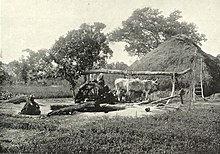

A sāqiyah or saqiya (Arabic: ساقية), also spelled sakia or saqia) is a mechanical water lifting device. It is also called a Persian wheel, tablia, rehat, and in Latin tympanum.[1] It is similar in function to a scoop wheel, which uses buckets, jars, or scoops fastened either directly to a vertical wheel, or to an endless belt activated by such a wheel. The vertical wheel is itself attached by a drive shaft to a horizontal wheel, which is traditionally set in motion by animal power (oxen, donkeys, etc.) Because it is not using the power of flowing water, the sāqiyah is different from a noria and any other type of water wheel.
The sāqiyah is still used in India, Egypt and other parts of the Middle East, and in the Iberian Peninsula and the Balearic Islands. It may have been invented in Ptolemaic Kingdom of Egypt, Iran, Kush or India. The sāqiyah was mainly used for irrigation, but not exclusively, as the example of Qusayr 'Amra shows, where it was used at least in part to provide water for a royal bathhouse.[2]
- ^ "Water lifting devices". Retrieved 28 May 2016.
- ^ "Qusayr 'Amra : Site Management Plan" (PDF). Whc.unesco.org. January 2014. Retrieved 2016-05-28.